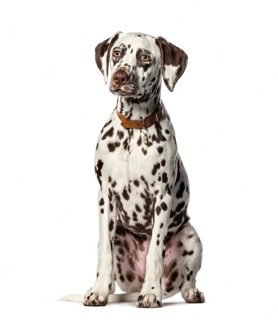
The Dalmatian is an elegant and playful breed with origins dating back to the 1600’s. As the name implies, they originated in the Dalmatian region of Croatia. Across the centuries, their role ranged from being a type of coach dog, guarding and military service to working in firehouses. The Dalmatian is a strong, medium-sized dog with a muscular body. Its unique and iconic spotted coat is one of its recognizable features, usually white and black, but also seen in liver, orange and even brindle colors. The breed has long been believed to be the result of combining Pointers, Greyhounds, Setters and Bulldogs. Dalmatians are known for their intelligence, loyalty and athleticism. They have webbed feet and a muscular head, with its distinctive black nose and long, square muzzle, large white or brown eyes, and well-rounded, feathered ears. What really sets them apart is their superb stamina, making them an ideal breed for running and other outdoor activities.
Dalmatians are known for being friendly and gentle, but they can be quite energetic as well. They are a very intelligent breed and love to play, but they are also quite patient and tolerant. Dalmatians are usually great with children and other pets, but early socialization and training are important in order to ensure a good relationship. They require regular exercise and activity, as their energy levels are high. Dalmatians can be kept indoors but, if kept outside, they need to be exercised regularly. Suitable activities to keep them busy include daily walks, runs, and plenty of playtime. They have strong bonds with their owners and make great family pets.
The Dalmatian is an active and highly energetic breed which requires a nutritious and balanced diet to sustain its energy levels. A high-quality dog food should provide plenty of lean proteins, essential fatty acids, carbohydrates, fiber and vitamins to meet the nutritional needs for optimal health. Proper physical activities is also important for Dalmatians, with one hour daily of training, playing and exercise. A healthy diet for a dog means taking into account the size, age and life stage of your specific Dalmatian. It is important to find the correct balance, as overeating or over feeding can lead to unwanted weight gain, which can cause health problems for your pet. It is important to adopt a responsible and knowledgeable pet ownership mindset and to draw up a feeding plan for your Dalmatian which takes into account all its nutritional requirements. Taking the time to research and learn about the nutritional needs of your pet, as well as understanding how much food and what types of food should be given can be a good aid in providing it with proper nourishment. We invite you to check out Way Canina to learn more about your furry friend and to find out what foods are safe for it, and which should be avoided. Remember, it is important to look out for your Dalmatian’s health and wellbeing, and a good diet is essential for them to lead happy and healthy lives.
It is important for owners to get regular veterinary check-ups and vaccinate their dogs, especially puppies, to help prevent common health issues. Prevention is key, so regular preventative care is essential to ensure your pup’s wellbeing. It is also important to maintain regular grooming habits, such as brushing, bathing, and ear cleaning, in order to keep them in good overall health. To keep your Dalmatian healthy and happy, providing them with a balanced diet, portion control, and regular exercise is paramount.
Dalmatians are an active breed of dog that require regular exercise and proper diet in order to remain healthy. The lifespan of a Dalmatian is typically 10 to 13 years, however, certain factors, such as genetics, diet, exercise, and healthcare, can influence the length of their life.
Are you a current or future owner of a Dalmatian? Before making any decisions, carefully consider the responsibilities, pros and cons of owning this active breed of dog. We encourage you to check out our blog posts and articles at Way Canina where you can compare different breeds and find more information on each breed’s lifestyle and wellbeing.